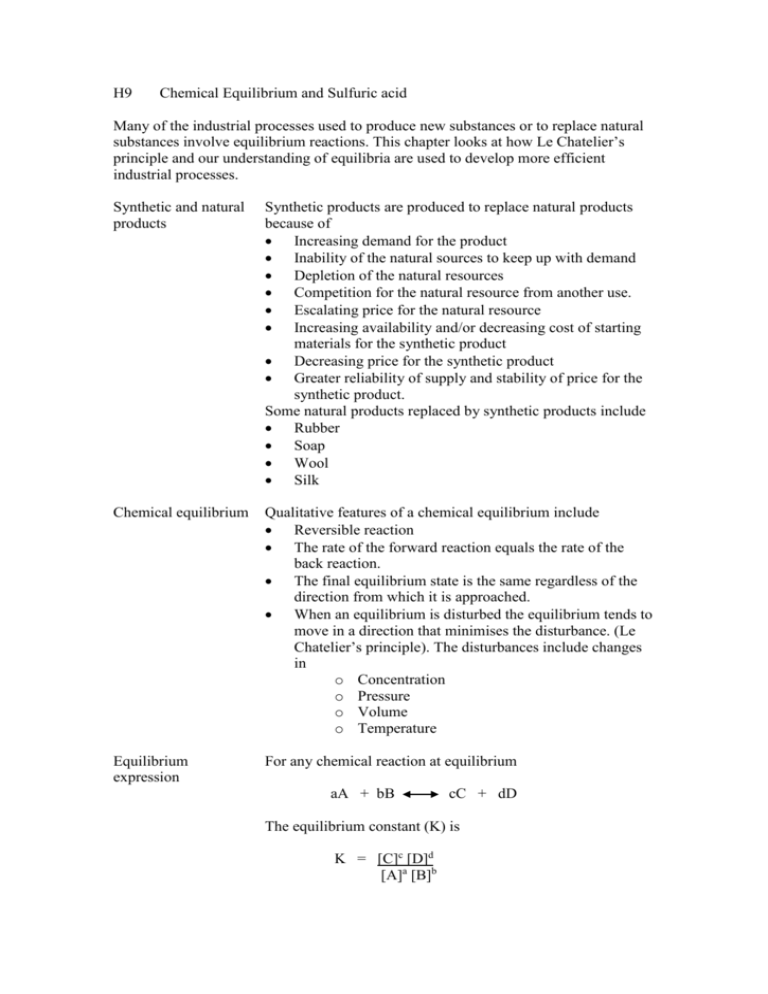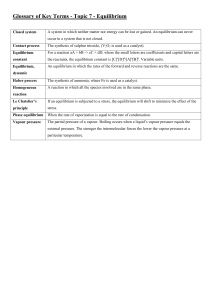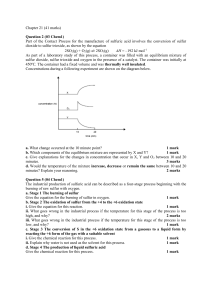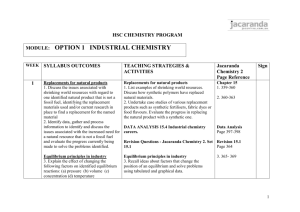maitland/5231/H9Chemical Equilibrium and Sulfuric
advertisement

H9 Chemical Equilibrium and Sulfuric acid Many of the industrial processes used to produce new substances or to replace natural substances involve equilibrium reactions. This chapter looks at how Le Chatelier’s principle and our understanding of equilibria are used to develop more efficient industrial processes. Synthetic and natural products Synthetic products are produced to replace natural products because of Increasing demand for the product Inability of the natural sources to keep up with demand Depletion of the natural resources Competition for the natural resource from another use. Escalating price for the natural resource Increasing availability and/or decreasing cost of starting materials for the synthetic product Decreasing price for the synthetic product Greater reliability of supply and stability of price for the synthetic product. Some natural products replaced by synthetic products include Rubber Soap Wool Silk Chemical equilibrium Qualitative features of a chemical equilibrium include Reversible reaction The rate of the forward reaction equals the rate of the back reaction. The final equilibrium state is the same regardless of the direction from which it is approached. When an equilibrium is disturbed the equilibrium tends to move in a direction that minimises the disturbance. (Le Chatelier’s principle). The disturbances include changes in o Concentration o Pressure o Volume o Temperature Equilibrium expression For any chemical reaction at equilibrium aA + bB cC + dD The equilibrium constant (K) is K = [C]c [D]d [A]a [B]b Q = [C]c [D]d [A]a [B]b Reaction quotient If Q< K, the reaction goes from left to right until Q = K If Q> K, the reaction goes from right to left until Q = K If Q = K, the reaction is at equilibrium. Writing equilibrium expressions The reaction quotient (and hence the equilibrium expression) is always written with products (right-hand side) in the numerator (top line) and the reactants (lefthand side) in the denominator (bottom line) Q or K = [products] [reactants] The equilibrium expression always uses the coefficients of the reaction as written in the balanced chemical equation. Units are not required for equilibrium constants but unless stated concentrations are always in mol L-1. Measuring equilibrium concentrations The equilibrium concentrations and therefore the equilibrium constant can be determined if the initial concentrations of the reactants are known and the equilibrium concentration of one reactant or product. Using the equilibrium constant Uses of sulfuric acid K can be used to decide whether a reaction is at equilibrium K can be used to calculate equilibrium concentrations Changes in K with temperature changes can be used to indicate if the reaction is exothermic or endothermic. Sulfuric acid is produced more than any other chemical and some of its uses include the manufacture of: Fertiliser Viscose rayon and other synthetic fibres Ethanol from ethene Pigments for paints, plastics and paper Detergents Explosives, drugs, dyes and pesticides Lead-acid batteries for cars Sulfuric acid is also used in Steel processing Oil refining Extraction of metals from their ores Frasch extraction of sulfur Sulfur is extracted from underground deposits of sulfur by the Frasch process which relies on sulfur’s: Low melting point Low density The industrial synthesis of sulfuric acid This industrial process involves three steps Conversion of sulfur to sulfur dioxide Conversion of sulfur dioxide to sulfur trioxide Absorption of sulfur trioxide to form sulfuric acid Properties of sulfuric acid Colourless Viscose Dense Non-volatile Boiling point 338oC Density 1.84g mL-1 Dilution with water is a very exothermic reaction (-90kJ mol-1) Dilute sulfuric acid is a very strong acid (completely dissociated) Concentrated sulfuric acid (98%) is almost completely associated. Moderately strong oxidising agent Cheapest of the common acids to produce. Reactions of sulfuric acid Acid-base reactions Precipitation reactions (barium and lead ions). Dehydration Oxidation Safety precautions when using sulfuric acid Always wear safety glasses Wear protective gloves and a laboratory coat or apron Work near a ready supply of running water Have a supply of sodium carbonate or sodium hydrogen carbonate nearby Store the acid in glass bottles no more than one litre. Avoid dribbling the acid down the side of the bottle Transport and storage Concentrated sulfuric acid can be transported and store in steel tankers but care must be taken to ensure that it does not become contaminated with water. Dilute sulfuric acid reacts vigorously with iron and steel and should be transported in glass or plastic containers.











